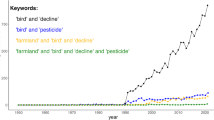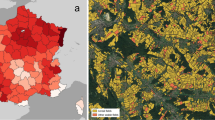Abstract
This paper reviews current EU pesticide risk assessment guidance [European Commission (2002) Guidance document on risk assessment for birds and mammals under council directive 91/414/EEC, SANCO/4145/2000EC 2002], and examines some of its assumptions and problems arising from them. Issues associated with obtaining data that adequately describes exposure over the appropriate time-scale are common to both acute and long-term risk assessments but are probably less problematic for long-term exposure. Improvements in problem formulation and ways in which temporal and spatial factors might be incorporated into long-term risk assessments are suggested. The most important temporal issue for long-term risk is how best to model the degree to which wildlife habits are predictable from day to day. In relation to spatial factors, it is suggested that long-term risk assessments could make better use of pesticide usage data that sample usage patterns throughout the UK. The usefulness of detailed simulated farming landscapes populated by wildlife represented as agent-based models, should be explored.

Similar content being viewed by others
References
Bennett, R.S., Dewhurst, I., Fairbrother, A., Hart, A.D.M., Hooper, M., Leopold, A., Mineau, P., Mortensen, S., Shore, R.F. and Springer, T. (2005). A new interpretation of avian and mammalian reproduction toxicity test data in ecological risk assessment. Ecotoxicology, this volume
Brewer, L.W., Sullivan, J.P., Akins, J.M., Kamiri, L.K. and Mihaich, E.M. (1997). Measured pesticide residues on insects in relation to standard EPA estimates. Platform Presentation to the Society of Environmental Toxicology and Chemistry 18th Annual Meeting, San Francisco, USA
Committee on Toxicity of Chemicals in Food, Consumer Products and the Environment (2002). Risk Assessment of Mixtures of Pesticides and Similar Substances. http://www.food.gov.uk/multimedia/pdfs/report(indexed).pdf
Corbet G.B., Harris S., (1991) The Handbook of British Mammals, 3 Blackwell Scientific, Oxford
CSL (1999). Validation of methods for testing the avoidance of treated seed by birds. MAFF Project PN0914, http://www2.defra.gov.uk/research/project_data
Crocker, D.R., Hart, A., Gurney, J. and McCoy, C. (2002). Methods for estimating daily food intake of wild birds and mammals. Central Science Laboratory, Project PN0908. Final Report. http://www.pesticides.gov.uk/general/ResearchReports/index.htm
Driver C.J., Ligotke M.W., Vanvoris P., Mcveety B.D., Greenspan B.J., Drown D.B., (1991) Routes of uptake and their relative contribution to the toxicologic response of northern bobwhite (Colinus virginianus) to an organophosphate pesticideEnviron. Toxicol. Chem. 10(1):21–33
European Commission (2002). Guidance document on risk assessment for birds and mammals under council directive 91/414/EEC, SANCO/4145/2000
ECOFRAM (1999). Draft terrestrial report of the Ecological Committee on FIFRA Risk Assessment Methods. http://www.epa.gov/oppefed1/ecorisk/terrreport.pdf
Edwards P.J., Bembridge, J., Jackson, D., Earl, M. and Anderson, L. (1998). Estimation of pesticides residues on weed seeds for wildlife risk assessment. Poster Presentation at the Society of Environmental Toxicology and Chemistry 19th Annual Meeting, 1998, Charlotte, NC, USA (summary on page 151 of abstract book)
Ferson S. (2001). Estimating exposure over time: how not to do it. In A Hart (ed.). Probabilistic Risk Assessment for Pesticides in Europe: Implementation and Research Needs. York: CSL. p. 75
Fischer, D. (2005). Accounting for differing exposures patterns between laboratory tests and the field in the assessment of long-term risks of pesticides to terrestrial vertebrates. Ecotoxicology, this volume
Fischer, D.L. and Bowers, L.M. (1997). Summary of field measurement of pesticide concentrations in invertebrate prey of birds. Unpublished Manuscript
Fletcher J.S., Nellessen J.E., Pfleeger T.G., (1994) Literature review and evaluation of the EPA food-chain (Kenaga) nomogram, in instrument for estimating pesticide residues on plantsEnviron. Toxicol. Chem. 9: 1383–91
FOCUS (2000): FOCUS Groundwater Scenarios in the EU review of active substances. Report of the FOCUS Groundwater Scenarios Workgroup, EC Document Reference Sanco/321/2000 rev 2, 202 pp
Fuller, M., Smith, G.M., Sanderson, J.M., Hill, R., Thomson, A., Cox, R., Brown, N.J., Clarke, R.T., Rothery, P. and Gerard, F.F. (2002). Land Cover Map 2000, module 7. Final report. http://www.cs2000.org.uk/Final_reports/M07_final_report.htm
Garthwaite, D.G., Thomas, M.R., Dawson, A. and Stoddart, H. (2003). Arable crops in Great Britain 2002. Pesticide Usage Survey Report 187, Central Science Laboratory, York
Glass, R. (2003). Development of improved methods for estimating pesticide residues on arthropods eaten by birds and mammals (PS2311). http://www2.defra.gov.uk/research/project_data/More.asp?I=PS2311&SCOPE=0&M=PSA&V=NR%3A080
Gonzalez-Valero J.F., Campbell P.J., Fritsch H.J., Grau R., Romijn K., (2000): Exposure assessment for terrestrial non-target arthropodsJ. Pest. Sc 73: 163–8
Grenot C., Pascal M., Buscarlet L., Francaz J.M., Sellami M., (1984) Water and energy balance in the water vole (Arvicola terrestris Sherman) in the laboratory and in the field (Haut-Doubs) FranceComp. Biochem. Physiol. A Comp. Physiol. 78: 185–6
Hamaker V., (1972) Decomposition: Quantitative aspects. In: Goring CAI, Hamaker JW, (eds) Organic Chemicals in the Soil Environment. Vol I. Marcel Dekker, Inc New York pp 253–340
Hart, A. and Thompson, H.M. (2001). Estimating pesticide residues on invertebrates eaten by birds and mammals. SETAC 22nd Annual Meeting, Baltimore, USA. Abstract Book, abstract no. PM291, p. 195, Pensacola, FL: SETAC
Joermann, G. (1998) Personal communication by E-mail (18 February 1998). Discussion paper for EPPO Sub-group Vertebrates
Kenaga, E.E. (1973). Factors to be Considered in the Evaluation of Toxicity of Pesticides to Birds in Their Environment. Environmental Quality and Safety, Vol. II, pp. 66–181. New York: Academic Press
Luttik, R. (1992). Environmental hazard/risk assessment of pesticides used in agriculture for birds and mammals. The Dutch concept. Part 1. Introduction and synopsis of the decision scheme. RIVM-report 679101006, 1992, pp 30
McKay H.V., Prosser P.J., Hart A.D.M., Langton S.D., Jones A., McCoy C., Chandler-Morris S.A., Pascual J.A., (1999) Do wood-pigeons avoid pesticide-treated cereal seed? J. Appl. Ecol. 36: 283–96
Mineau P., (2002) Estimating the probability of bird mortality from pesticide sprays on the basis of the field study recordEnviron. Toxicol. Chem. 21(7):1497–506
Nagy K.A., (1987) Field metabolic rate and food requirement scaling in mammals and birdsEcol. Monogr. 57: 111–128
Pfleeger T.G., Fong A., Hayes R., Ratsch H., Wickliff C., (1996) Field evaluation of the EPA (Kenaga) nomogram, a method for estimating wildlife exposure to pesticide residues on plantsEnviron. Toxicol. Chem. 15(4): 535–43
Pyke G.H., Pulliam H.R., Charnov E.L., (1977). Optimal foraging theory: a selective review of evidence and testsQuart. Rev. Biol. 52: 137–54
Roelofs, W., Crocker, D.R., Shore, R.F., Moore, D.R.J., Smith, G., Akcakaya, H.R., Bennett, R.S., Chapman, P.F., Clook, M., Crane, M., Dewhurst, I.C., Edwards, P.J., Fairbrother, A., Ferson, S., Fischer, D., Hart, A.D.M., Holmes, M., Hooper, M.J., Lavine, M., Leopold, A., Luttik, R., Mineau, P., Mortenson, S.R., Noble, D.G., O’Connor, R.J., Sibly, R.M., Spendiff, M., Springer, T.A., Thompson, H.M. and Topping, C. (2005). Case study Part 2: Probabilistic modelling of long-term effects of pesticides on individual breeding success in birds and mammals. Ecotoxicology, this volume
SCP (2002) Opinion of the Scientific Committee on Plants on the draft guidance document on risk assessment for birds and mammals under directive 91/41/414/EEC. http://europa.eu.int/comm/food/fs/sc/scp/out125_ppp_en.pdf
Shore, R.F., Crocker, D.R., Akcakaya, H.R., Bennett, R.S., Chapman, P.F., Clook, M., Crane, M., Dewhurst, I.C., Edwards, P.J., Fairbrother, A., Ferson, S., Fischer, D., Hart, A.D.M., Holmes, M., Hooper, M.J., Lavine, M., Leopold, A., Luttik, R., Mineau, P., Moore, D.R.J., Mortenson, S.R., Noble, D.G., O’Connor, R.J., Roelofs, W., Sibly, R.M., Smith, G., Spendiff, M., Springer, T.A., Thompson, H.M. and Topping, C. (2005). Case studies Part 1: How to calculate appropriate deterministic long-term toxicity to exposure ratios (TERs) for birds and mammals. Ecotoxicology, this volume
Speakman J.R., (1999) The cost of living: Field metabolic rates of small mammalsAdv. Ecol. Res. 30:177–297
Stamper J.H., Nigg H.N., Allen J.C., (1979) Organophosphorous insecticide disappearance from leaf surfaces. An alternative to first order kineticsEnviron. Sci. Technol. 13: 1402–5
Stafford J.M., Brewer L.W., Gessaman J.A., (2003) Avian food selection with application to pesticide risk assessment: Are dead and desiccated insects a desirable food source? Environ. Toxicol. Chem. 22: 1335–9
Thompson H.M., (1996) Interactions between pesticides; a review of reported effects and their implications for wildlife risk assessmentEcotoxicology 5(2): 59–81
Tinbergen, J.M., Dietz, M.W. (1994) Parental energy-expenditure during brood rearing in the great tit (parus-major) in realtion to body-mass, temperature, food availability and clutch sizeFunct. Ecol. 8: 563–72
Topping C.J., Odderskaer P., (2004) Modeling the influence of temporal and spatial factors on the assessment of impacts of pesticides on skylarksEnviron. Toxicol. Chem. 23(2):509–20
Willis G.H., McDowell L.L., Southwick L.M., Smith S., (1985) Toxaphene, methyl parathion and fenvalerate disappearance from cotton foliage in the Mid SouthJ. Environ. Qual. 14: 446–50
Willis G.H., McDowell L.L., (1987): Pesticide persistence on foliageRev. Environ. Contam. Toxicol. 100: 23–73
Zaranyika, M.F., Mugari, P., (1996) Uptake of endosulphan and lindane by crickets ((Orthoptera) spiders (Arachnida), grasshoppers (Orthoptera) and beetles (Coleoptera), following application of the pesticides for the control of soya bean and maize pests respectively in a field trial in ZimbabweJ. Environ. Sci. Health Part B-Pesticides Food Contam. Agri. Wastes 31: 485–94
Acknowledgments
I am very grateful to the Pesticides Safety Directorate, Department for Environment, Food and Rural Affairs, UK who funded the collection of data essential to the estimates of wildlife food intake rates and radio-telemetry estimates of arable habitat use by birds and mammals and for funding the workshop. Steve Fryday pointed out the problems that can arise when attempting to incorporate pesticide avoidance into exposure estimates. Thanks also to Andy Hart for the suggestion to recast the standard exposure equation, and to Willem. Roelofs for ideas on how to do it. Thanks also to Mark Clook and Pierre Mineau who commented and offered revisions.
Author information
Authors and Affiliations
Corresponding author
Rights and permissions
About this article
Cite this article
Crocker, D. Estimating the Exposure of Birds and Mammals to Pesticides in Long-term Risk Assessments. Ecotoxicology 14, 833–851 (2005). https://doi.org/10.1007/s10646-005-0031-7
Accepted:
Published:
Issue Date:
DOI: https://doi.org/10.1007/s10646-005-0031-7




